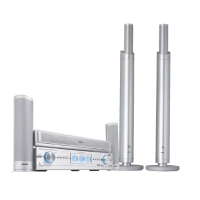Circuit-, IC descriptions and list of abbreviations
EN 133LX9000R 9.
9.2.6 Fan Control
To avoid unwanted temperatures inside the set (especially the
Laser on the OPU of the drive is very sensitive) a fan is located
on top of the basic engine. The speed control is dependent on
the ambient temp. A NTC resistor [3134] located on the display
board measures the temperature. An operational amplifier
[7902-B] generates a proper voltage, which is then fed to the
engine (“BE_FAN”-line). Below 28°C ambient temp. the fan-
voltage is approx. 5V and is increased to 10V when the ambient
temperature goes up to approx. 38°C. The second part of the
Op-Amp. [7902-A] prevents damage of any temperature-
sensitive part in case the NTC or the wire in between is
damaged. It acts as a comparator and pulls the “BE_FAN”-
signal to 10V. As the fan has to be stopped in case the tray of
the drive is open this voltage is “killed” by the CC (“FAN_OFF”-
signal). The double-diode [6901] acts for both Op.-Amp.-
circuits. The circuit is also prepared for a set-fan (circuit around
the Op-Amp. [7902-C] ).
9.3 Analog board Europe
9.3.1 General
This PCB consists out of the following parts:
– Power-Supply-Unit
– Frontend (Audio & Video)
– Input-/Output-switching
– Audio ADC- & DAC-processing
– VPS/PDC- and Text-Data slicer
– Analog Follow-Me Circuit
All functional groups are either controlled via I2C-bus or via
separate signal lines by the Central-Controller on the µP-Sub-
Board. This sub board is directly soldered in onto the analog
PCB. During Stand-By mode of the set, several parts are not
supplied (Tuner, MSP, ...). The microprocessor is running and
maintains the clock of the set.
To avoid bus blockades the I2C-bus (“SCLSW” & “SDASW”) to/
from these units is decoupled via transistors [7419], [7420]
from the general bus (“SCL” & “SDA”).
9.3.2 Frontend
This unit is designed to support two basic versions, which are
distinguished by a different assembly variant only (one for
multistandard and the second for Pal-I only) and comprises the
following parts:
• Tuner UV1316K [1705]
• IF amplifier & video demodulator IC TDA 9818/9817 [7710]
• Sound processor MSP3415G [7600]
Tuner and IF selection
The Tuner [1705] converts the RF-signal coming from the
antenna input to an IF-signal. The tuner is fully controlled via
I
2
C-bus of the CC-µP. [1705] is also equipped with a “passive-
loop-through” between antenna-in and -out to save power in
stand-by of the set, when the complete part is not supplied.
The IF frequency of the video carrier is 38.9 MHz for all
systems except SECAM L' (34,0 MHz).
A quasi-split audio system is used. Separate surface-wave
filters (SAW) are required. [1701], [1703] for video, [1702] for
audio. [1701] is switched into the signal path for DK/I-SECAM
L/L' reception, if the signal “SFS_TS” is “high”. In this case the
switches [7704], [7705] are open and the diode [6703] is
conducting. [1703] is switched into the signal path for BG
reception (“SFS_TS” is “low”). Then the switch [7712] is open
and the diode [6704] is conducting. For DK/I-SECAM L/L'
reception, an additional circuit for suppressing the audio carrier
of the adjacent channel is used. This circuitry is adjusted by coil
[5710] for maximum suppression at 40.4MHz.
IF demodulator
The signal from the tuner and IF-selection circuit is processed
by the demodulator IC TDA 9818/9817 [7710]. The signal
“PSS” to pin 3 switches between demodulation of positive
(SECAM only) or negative modulated video carriers. A QSS-
audio-IF signal SIF1 is generated for demodulation in the
sound processor [7600]. The audio-IF carrier is selected in the
audio SAW filter [1702]. This filter is switched for SECAM L’. If
the signal “SB1” is “high”, the switch [7714] is closed and the
diode [6705] is not conducting. For all other standards the
diode [6705] is conducting and the switch [7714] is open. The
output signal of this SAW filter is firstly processed in the TDA
9818. Audio carriers are converted from the tuner IF level to the
audio IF position and further processed in the audio
demodulator [7600]. The AFC coil [5711] on the TDA 9818/
9817 is adjusted so that when a frequency of 38.90 MHz is
supplied to the IF output of the tuner, the AFC voltage on pin
17 of [7710] is 2.5V. The setting of the picture carrier frequency
for SECAM L in the TDA 9818 is achieved by connecting pin 7
of the IC via a resistor [3710] to ground. The switch [7701] and
the signal “SB1" do this. The HF-AGC is set using the
potentiometer [3724] so that, with a sufficiently large antenna
input signal (74 dBµV), the voltage at the IF output of the tuner
[1705] pin 11 is 500 mVpp. This setting must be carried out
when the audio carrier is switched off. The demodulated video
signal appears on pin 16 of [7710]. The AGC voltage at pin 4 is
used to determine the antenna signal strength after a buffer
[7717] with the signal “AGC” and an analog input port of the
CC-P. The trap [1704] reduces the sound carrier remainders in
the video for BG standards. The trap [1706] works in the same
way for the Pal-I standard only. For all other standards the
switch [7713] is closed via [7706] and “SFS_TS”-line set “high"
to bypass this trap. In these cases the selectivity of the SAW
filter [1701] is sufficient. The coil [5713] for non-BG standards
realizes a frequency response correction. This correction is not
desired for SECAM L' and therefore short-circuited by [7716]
(signal SB1 is “high” and [7702] has on-status). The
demodulated video signal “VFV” is available after the buffer
and limiting stage for noise peaks [7711]. The FM-PLL
demodulator function of TDA 9818 is not necessary and
therefore deactivated by the resistor [3739].
Audio demodulator
The sound demodulation is done by the MSP3415 [7600],
which is also fully controlled via I
2
C-bus by the CC-P
(determination of bandwidth, amplitude, standard, ...).The
audio signals are available at pin 30 and pin 31 of [7600] and
fed as “AFER”- & “AFEL”-line to the audio-I/O for further
processing.

